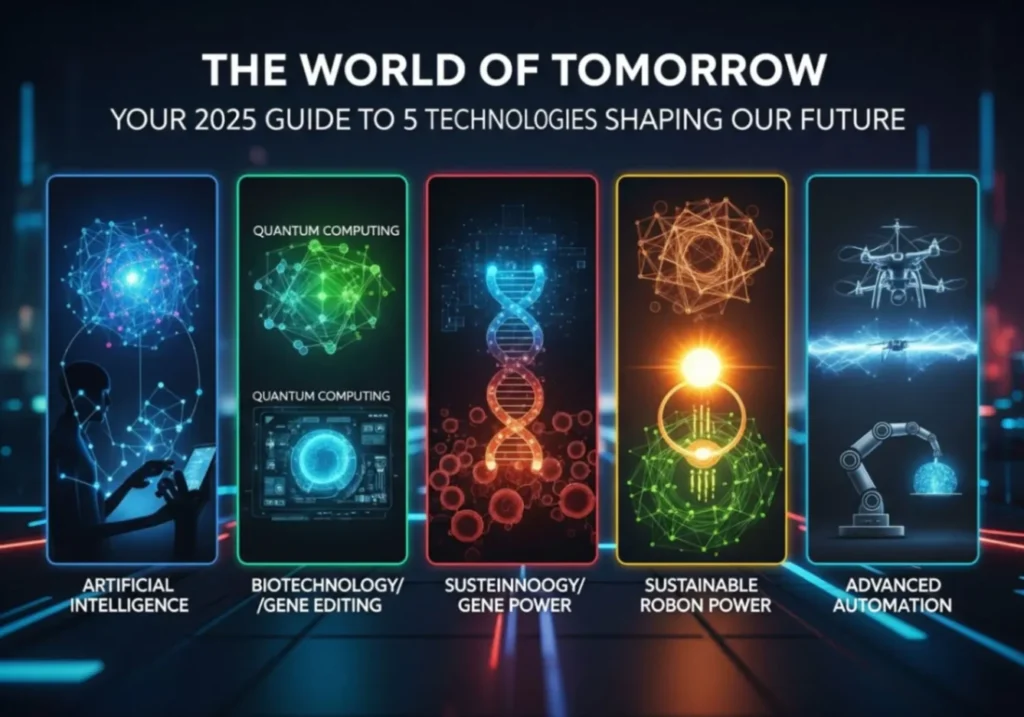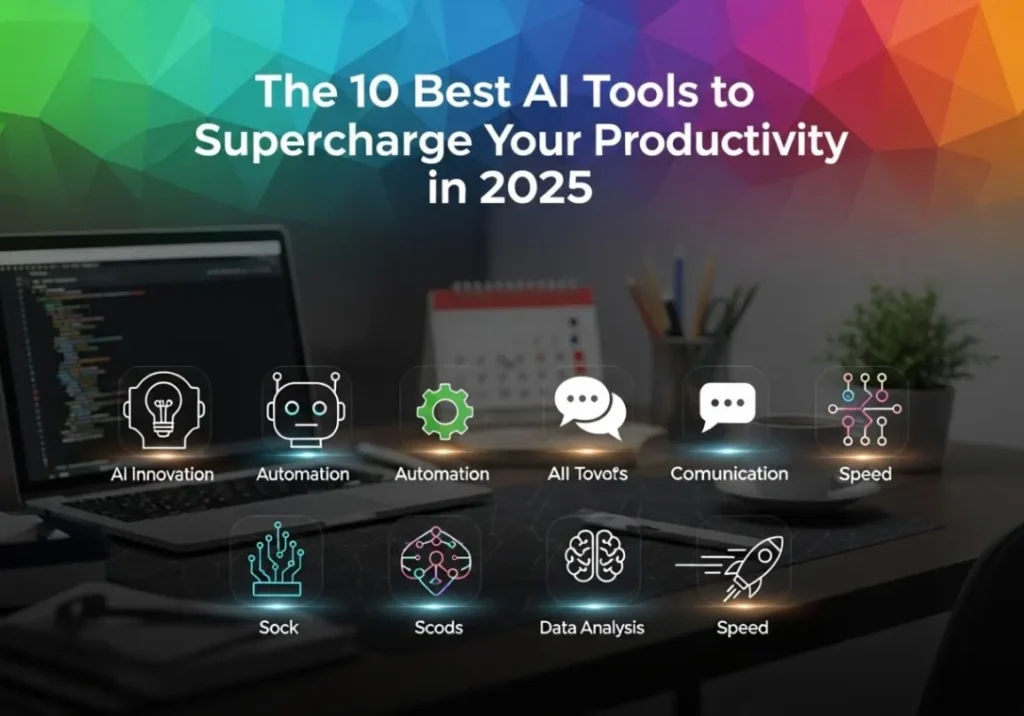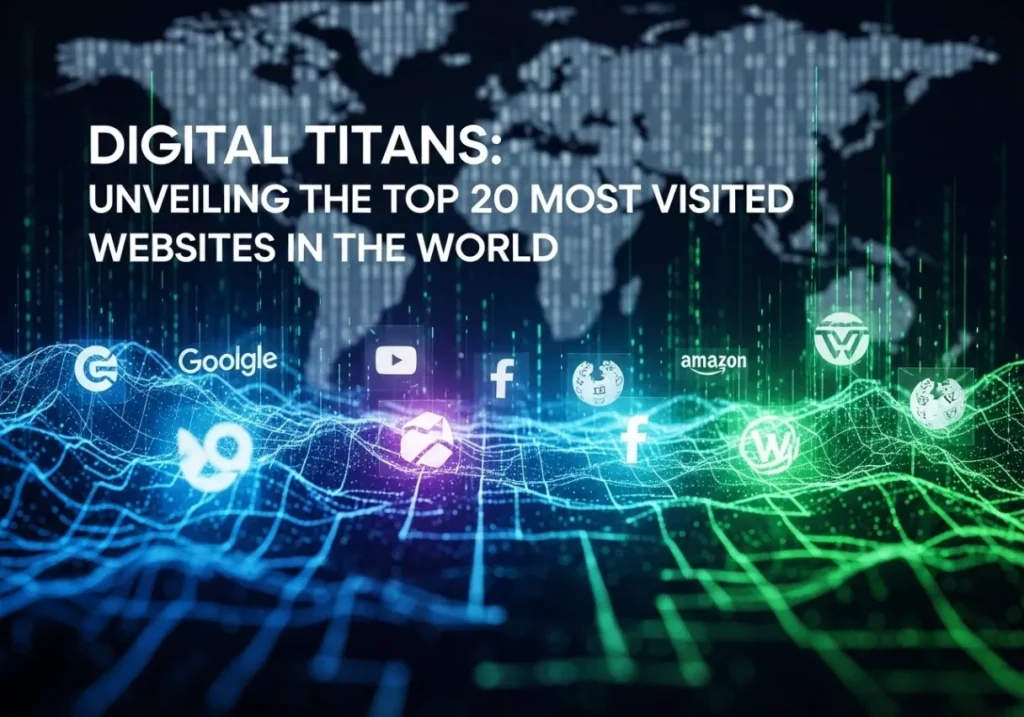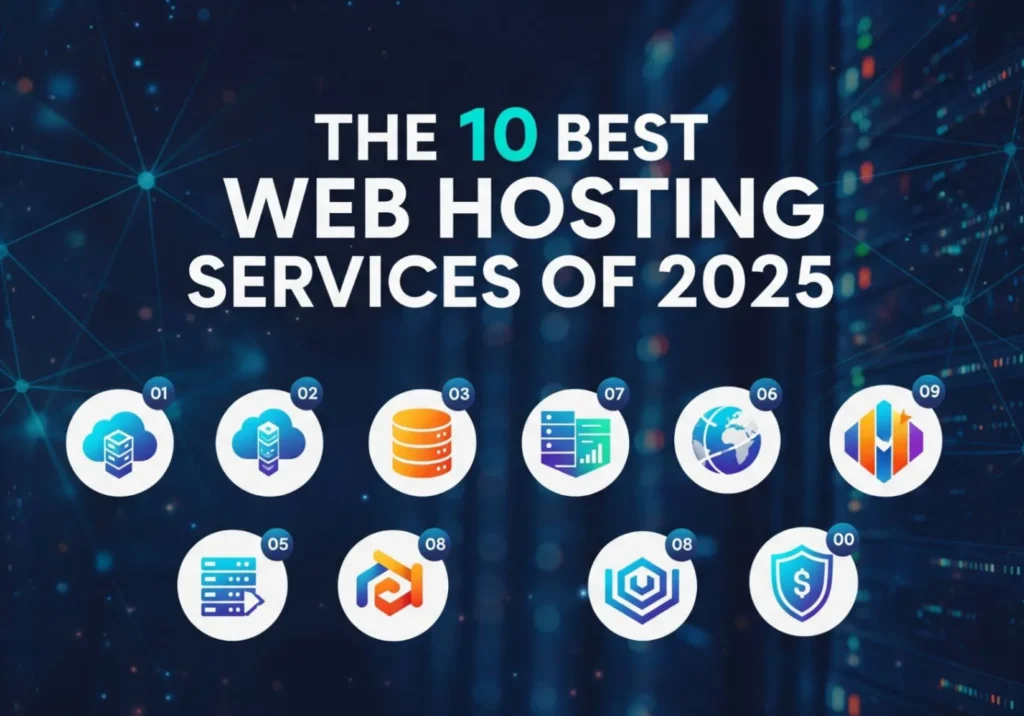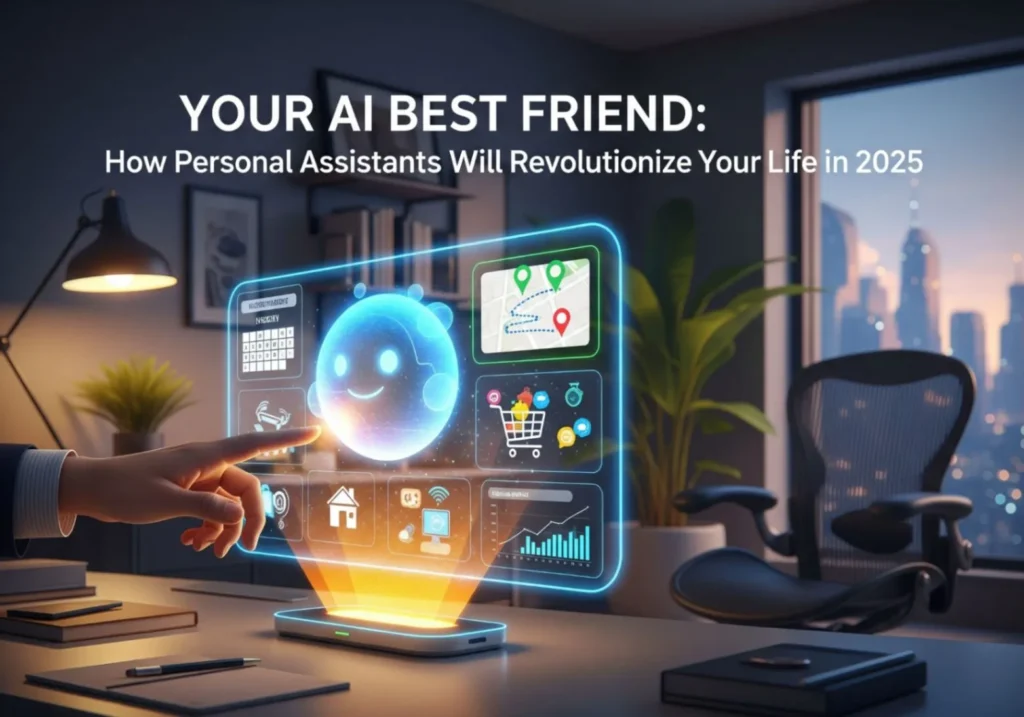The World of Tomorrow: Your 2024-2025 Guide to 5 Technologies Shaping Our Future
Ever feel like the future is arriving faster than you can keep up? Just a decade ago, the idea of a personal AI assistant in your pocket or a private company launching rockets to the Moon felt like science fiction. Today, it’s reality.
The pace of scientific and technological advancement is accelerating at a breathtaking rate. The changes we’re about to witness in 2024, 2025, and beyond won’t just be incremental upgrades—they will be foundational shifts that redefine how we live, work, and interact with the world around us.
This isn’t just about faster smartphones or more realistic video games. We are on the cusp of revolutions in intelligence, energy, exploration, and even what it means to be human. In this comprehensive guide, we’ll journey into the heart of five of the most electrifying fields poised for groundbreaking change:
- Artificial Intelligence (AI): Beyond chatbots to autonomous agents that act on our behalf.
- Renewable Energy: Innovations that could finally tip the scales in the fight against climate change.
- Space Exploration: A new era of lunar landings and cosmic discovery.
- Biotechnology: The dawn of personalized medicine and editing the very code of life.
- Robotics: From factory floors to our homes, machines are becoming more capable and collaborative than ever.
Strap in and get ready to see what the future holds. It’s arriving now, and it’s going to be extraordinary.
Table of Contents
- 1. Artificial Intelligence (AI): The Dawn of the Digital Mind
- 2. Renewable Energy: Powering Our Planet, The Clean Way
- 3. Space Exploration: Humanity’s Next Giant Leap
- 4. Biotechnology: Rewriting the Manual for Life
- 5. Robotics: The Rise of Helpful Machines
- Conclusion: Embracing an Astonishing Future
- Frequently Asked Questions (FAQ)
1. Artificial Intelligence (AI): The Dawn of the Digital Mind
Imagine a brain that can absorb the entire internet in an instant, identify patterns invisible to humans, and learn new skills without ever getting tired. That’s the essence of Artificial Intelligence (AI). In simple terms, AI is the science of making machines that can think, reason, and learn like humans—and in some cases, far beyond our own capabilities.

Agentic AI: The Proactive Assistant
One of the most significant leaps forward is the concept of Agentic AI. For the last few years, we’ve interacted with reactive AI—we ask a question, it gives an answer. Agentic AI flips the script. It’s AI that can take a complex goal, break it down into steps, and execute those steps autonomously without constant human intervention.
Example: Instead of asking an AI, “What are the best-rated hotels in Tokyo for May?” you could give an agentic AI the goal: “Plan and book my 5-day trip to Tokyo in May within a $3,000 budget, prioritizing cultural sites and good food.” The AI agent would then research flights, compare hotels, check your calendar for conflicts, book reservations, and present you with a finished itinerary. Experts predict that by 2028, such AI agents could be making a significant portion of everyday operational decisions in businesses, revolutionizing efficiency.
Micro LLMs: AI Power in Your Pocket
Large Language Models (LLMs) like GPT-4 are the massive, cloud-based engines behind tools like ChatGPT. They are incredibly powerful but require immense computing resources. The next wave is Micro LLMs—smaller, highly efficient versions that can run directly on your personal devices, like your smartphone or laptop.
This has two huge implications:
- Privacy & Security: Your data doesn’t have to be sent to a cloud server to be processed. It stays on your device, making it much more secure.
- Accessibility & Speed: Powerful AI tools can work offline, instantly, without an internet connection. This will democratize access to advanced AI for individuals and small businesses everywhere.
Generative AI: The Creative Machine
This is the AI that has captured the public’s imagination. Generative AI doesn’t just analyze data; it creates entirely new, original content. This includes writing human-like text, composing music, generating photorealistic images from a simple prompt (e.g., DALL-E, Midjourney), and even writing functional code. Its growing creative and logical power is set to disrupt and enhance industries from marketing and media to software development and design.
AI Governance: The Essential Rulebook
With great power comes great responsibility. As AI becomes woven into the fabric of society, ensuring it’s used ethically and safely is paramount. This has led to the rise of AI Governance. Think of it as a quality control and safety system for AI. Landmark regulations like the EU AI Act are creating a legal framework for AI development, categorizing applications by risk level. This focus on responsible innovation is crucial for building public trust and ensuring AI benefits all of humanity.
Why This AI Revolution Matters
AI’s potential is staggering. It’s not one single technology but a versatile tool with a profound impact:
- Healthcare: Aiding doctors in detecting diseases like cancer earlier by analyzing medical scans with superhuman accuracy.
- Scientific Discovery: Accelerating research by modeling complex systems, from protein folding (AlphaFold) to climate change.
- Efficiency: Automating repetitive tasks, freeing up human workers to focus on creativity, strategy, and complex problem-solving.
- Accessibility: Powering real-time translation tools that break down language barriers and creating assistive technologies for people with disabilities.
Key Takeaway: AI is evolving from a reactive tool to a proactive partner. Agentic AI, on-device models, and responsible governance will make AI a more powerful, personal, and integral part of our daily lives.
2. Renewable Energy: Powering Our Planet, The Clean Way
Imagine a world powered by sources that never run out, produce zero emissions, and protect our environment. That’s the promise of renewable energy. Unlike finite and polluting fossil fuels (coal, oil, and gas), renewables harness the limitless power of the sun, wind, and water. Here are the innovations making that future a reality.

Solar Power Innovations
- Perovskite Solar Cells: This is a game-changer. For decades, solar panels have relied on silicon. Perovskite is a new material that is not only potentially more efficient but also far cheaper to produce. Because it can be “printed” onto flexible surfaces, it opens the door for solar power to be integrated into windows, vehicles, and even clothing.
- Bifacial Solar Panels: Why only use one side? These clever panels capture direct sunlight from the front and reflected light from the back, boosting energy generation by up to 25%. Companies like SunPower and Tesla are already deploying them in large-scale farms.
- Solar Canopies: Making smart use of existing space, these are large solar-panel-covered structures built over parking lots. They provide shade for cars while generating clean electricity to power buildings or on-site EV charging stations.
Wind Energy Advancements
- AI-Optimized Wind Farms: AI algorithms can now analyze complex weather patterns and topographical data to determine the absolute best placement for each turbine in a wind farm, maximizing energy capture and minimizing turbulence between turbines.
- Residential & Bladeless Wind Turbines: It’s not just for giant farms anymore. Smaller, quieter turbines are being designed for individual homes and communities. Some futuristic designs are even “bladeless,” resembling a tall, vibrating cylinder. They are safer for birds and less visually intrusive, promoting energy independence.
Solving the Storage Puzzle: The Holy Grail of Renewables
The biggest challenge for renewables has always been intermittency—the sun doesn’t always shine, and the wind doesn’t always blow. That’s why breakthroughs in energy storage are so critical.
- Solid-State Batteries: The next generation of battery technology. By using solid materials instead of the liquid electrolytes found in today’s lithium-ion batteries, they are safer (non-flammable), last longer, and can store significantly more energy in the same amount of space. This is a crucial technology for both electric vehicles and grid-scale storage.
- Grid-Scale Energy Storage: Think of these as giant, rechargeable power banks for an entire city or region. Technologies like massive battery farms and innovative “flow batteries” store vast amounts of excess solar and wind energy. When demand is high or generation is low, this stored clean energy is released back into the grid, ensuring a reliable 24/7 power supply.
Why the Push for Renewables is Unstoppable
The transition to renewables isn’t just an environmental choice; it’s an economic and security imperative.
- Climate Action: It’s our single most powerful tool for reducing the greenhouse gas emissions that drive climate change.
- Clean Air and Water: Renewables produce little to no pollution, leading to better public health outcomes.
- Energy Independence: Nations can rely on their own natural resources instead of being subject to volatile global fossil fuel markets.
Key Takeaway: Innovations in materials like perovskite and breakthroughs in energy storage are making renewable energy cheaper, more efficient, and more reliable than ever, accelerating the global transition away from fossil fuels.
3. Space Exploration: Humanity’s Next Giant Leap
Humans are explorers by nature. Our gaze has always turned to the stars, and in 2024 and 2025, we’re taking some of our boldest steps yet into that final frontier.

Our Next Steps: A Commercial Return to the Moon
NASA’s Commercial Lunar Payload Services (CLPS) program marks a paradigm shift. Instead of building all its own landers, NASA is partnering with private companies like Intuitive Machines and Firefly Aerospace to deliver scientific instruments to the Moon. These robotic missions are scouting landing sites, studying lunar ice, and testing technologies that will pave the way for the return of astronauts under the Artemis program.
Exploring the Red Planet: The Mars Sample Return Quest
NASA’s Perseverance rover continues its incredible mission on Mars, searching for signs of ancient microbial life. But its most important job is collecting and caching compelling rock and soil samples. The long-term plan is a multi-mission collaboration with the European Space Agency (ESA) to launch a future spacecraft to Mars, retrieve these samples, and bring them back to Earth for analysis in our most advanced labs—a quest that could finally answer if we are alone in the universe.
Fueling Deep Space: SpaceX’s Starship Game-Changer
SpaceX’s massive Starship rocket is designed to be a fully and rapidly reusable transportation system to carry humans to the Moon, Mars, and beyond. A critical technology test planned is in-orbit propellant transfer—essentially, refueling one Starship from another in space. Mastering this “gas station in orbit” is the key to enabling long-duration, deep-space voyages, making interplanetary travel more feasible and affordable than ever imagined.
Mapping the Universe: The SPHEREx Observatory
Set to launch in early 2025, NASA’s SPHEREx telescope will do something extraordinary: it will survey the entire sky multiple times in near-infrared light, which is invisible to the human eye. This will create a monumental 3D map of the cosmos, providing a treasure trove of data for astronomers. Its main goals are to study how the universe began, how galaxies formed and evolved over billions of years, and where the ingredients for life originated.
Watching Our Home Planet: The NISAR Mission
A joint mission between NASA and the Indian Space Research Organisation (ISRO), NISAR (NASA-ISRO Synthetic Aperture Radar) is one of the most advanced Earth-observing satellites ever built. Launching in 2025, it will scan nearly all of Earth’s land and ice surfaces every 12 days with stunning precision. It can detect tiny movements of the Earth’s crust, helping us monitor volcanoes, predict earthquakes, track changes in forests, and measure the melt of glaciers—invaluable data for protecting our home planet.
Why Reaching for the Stars Matters
Space exploration pushes the boundaries of human knowledge and capability.
- Innovation: The challenges of space travel lead to inventions that benefit us on Earth (GPS, memory foam, camera phones).
- Perspective: Seeing Earth from afar helps us appreciate its fragility and our shared home.
- Inspiration: It encourages new generations to pursue careers in science, technology, engineering, and math (STEM).
Key Takeaway: A new era of space exploration, driven by public-private partnerships, is underway. Missions to the Moon, Mars, and beyond are not just about discovery but also about developing technologies that can help us right here on Earth.
4. Biotechnology: Rewriting the Manual for Life
Biotechnology is a field where science fiction is rapidly becoming science fact. It involves using living organisms (like cells or bacteria) or their components to create products or solve problems, particularly in medicine and agriculture. The breakthroughs happening now are poised to revolutionize human health.

Fixing Our Genes: The Power of CRISPR Technology
Arguably the biggest breakthrough in biology in the last century is CRISPR gene editing. Think of it as a biological “find and replace” tool for our DNA. CRISPR-Cas9 technology acts like a pair of “molecular scissors” that can be programmed to find a specific gene, cut it out, and even replace it with a corrected version. This has staggering potential to cure genetic diseases at their source. Clinical trials are already showing incredible success in treating conditions like sickle cell anemia and beta-thalassemia by correcting the faulty gene in a patient’s own cells.
Medicine Just For You: The Rise of Personalized Treatments
For decades, medicine has largely followed a one-size-fits-all approach. Personalized (or precision) medicine changes that. By analyzing an individual’s unique genetic makeup, lifestyle, and environment, doctors can tailor treatments specifically for them.
Example: Instead of standard chemotherapy for all lung cancer patients, a doctor can sequence the genetics of a patient’s tumor. If a specific mutation is found, they can prescribe a targeted drug designed to attack only the cells with that mutation, leading to higher success rates and far fewer side effects.
Spotting Sickness Sooner: Advanced Diagnostics
The best way to treat a disease is to catch it early. Biotechnology is fueling a revolution in diagnostics. Advancements in molecular diagnostics and “liquid biopsies” (simple blood tests) can detect tiny fragments of DNA shed by cancer cells, allowing for detection long before a tumor is visible on a scan. Furthermore, AI is being integrated with medical imaging to help radiologists spot signs of disease that are imperceptible to the human eye, dramatically improving outcomes.
The Transformative Power of Biotech
Biotechnology’s influence extends across society:
- Disease Treatment: Creating novel vaccines (like the mRNA vaccines for COVID-19), gene therapies, and targeted cancer drugs.
- Tissue Regeneration: Using stem cells to repair or replace damaged tissues and organs.
- Sustainable Agriculture: Developing crops that are more nutritious, drought-resistant, and require fewer pesticides.
Key Takeaway: Biotechnology is moving medicine from treating symptoms to curing diseases at their genetic source. Personalized treatments and early diagnostics are making healthcare more effective and tailored to the individual than ever before.
5. Robotics: The Rise of Helpful Machines
A robot is more than just a metal caricature; it’s a machine capable of carrying out complex actions automatically, often performing tasks that are dangerous, repetitive, or require superhuman precision. The line between machine and collaborator is blurring faster than ever.

The Rise of the Humanoids: Robots That Walk Among Us
For years, humanoid robots were clumsy and confined to labs. Now, companies like Boston Dynamics (with its Atlas robot) and Tesla (with Optimus) are developing robots that can walk, run, and manipulate objects with stunning agility. The goal is not to replace humans but to assist them in environments designed for people. Potential applications include logistics in warehouses, assistance in manufacturing, and eventually, helping with tasks in elder care facilities or homes.
Smart Safety: Can a Robot Learn “Fear”?
Scientists are developing robots with what could be described as a simulated sense of “fear.” The goal isn’t to give robots emotions but to equip them with advanced risk-assessment and self-preservation protocols. A robot operating in a disaster zone that senses an unstable structure might automatically back away to avoid being crushed. This allows it to protect itself so it can complete its primary mission safely, demonstrating a new level of situational awareness.
The Hidden World of Robots Around Us
You interact with robotics far more than you probably realize:
- At Home: Robotic vacuum cleaners autonomously navigate and clean your floors.
- In Healthcare: Surgical robots like the da Vinci system allow surgeons to perform complex procedures with greater precision and smaller incisions. Robotic prosthetics can restore a sense of touch and movement.
- In Industry: Armies of robots assemble everything from cars to smartphones in highly automated factories.
- In Space: Robotic rovers like Perseverance explore the surface of Mars, acting as our remote geologists.
How Robots are Reshaping Our World
- Automation & Safety: Handling jobs that are dull, dirty, and dangerous, protecting human workers from harm.
- Assistance: Helping people with disabilities gain more independence and improving the quality of care for the elderly.
- Efficiency: Streamlining processes in logistics, manufacturing, and agriculture, leading to lower costs and higher productivity.
Key Takeaway: Robotics is moving beyond simple automation. With advancements in AI and mobility, robots are becoming true collaborators, capable of working alongside humans safely and effectively in complex, real-world environments.
Conclusion: Embracing an Astonishing Future
The world of tomorrow is not a distant dream; its foundations are being laid today. The exponential progress in Artificial Intelligence, Renewable Energy, Space Exploration, Biotechnology, and Robotics promises a future that is more intelligent, sustainable, expansive, and healthy.
From AI agents that streamline our lives to gene-editing tools that cure disease, these technologies hold immense potential to solve some of humanity’s greatest challenges. Understanding these incredible advancements is the first step toward navigating and shaping the amazing world that lies just ahead. The future is now, and we all have a front-row seat.
Frequently Asked Questions (FAQ)
1. Which of these technologies will have the biggest impact first?
While all are transformative, Artificial Intelligence (AI) is likely to have the most widespread and immediate impact. Its ability to be integrated into almost every other field—from optimizing renewable energy grids to accelerating biotech research—makes it a “meta-technology” that will amplify the progress of all the others.
2. Should we be worried about AI and robots taking over jobs?
It’s a valid concern. Historically, technology has displaced certain jobs while creating new ones. AI and robotics will undoubtedly automate many repetitive tasks. However, this will also create new roles focused on AI management, robotics maintenance, data science, and tasks requiring human creativity, critical thinking, and empathy. The key will be societal adaptation and a focus on education and retraining.
3. How realistic is a future powered 100% by renewable energy?
A 100% renewable future is technologically feasible and increasingly economically viable. The primary hurdles are no longer about generation but about storage and grid modernization. The breakthroughs in battery technology and grid-scale storage discussed in this article are the keys to overcoming the intermittency of solar and wind, making a fully renewable grid a realistic goal for the coming decades.
4. Isn’t gene editing like CRISPR dangerous or unethical?
CRISPR technology carries significant ethical considerations, especially concerning edits to the human germline (sperm, eggs, embryos) that could be passed down through generations. For this reason, the global scientific community has established strict guidelines, and most research is focused on “somatic” gene editing, which affects only the individual patient and is not heritable. The debate around its use is ongoing and crucial for ensuring it is developed responsibly.
5. How can I stay up-to-date with all these changes?
Following reputable science and technology news sources (like MIT Technology Review, WIRED, Ars Technica), listening to podcasts on the subject, and reading in-depth articles like this one are great ways to stay informed. The key is to cultivate a sense of curiosity and a willingness to learn about the forces shaping our world.
